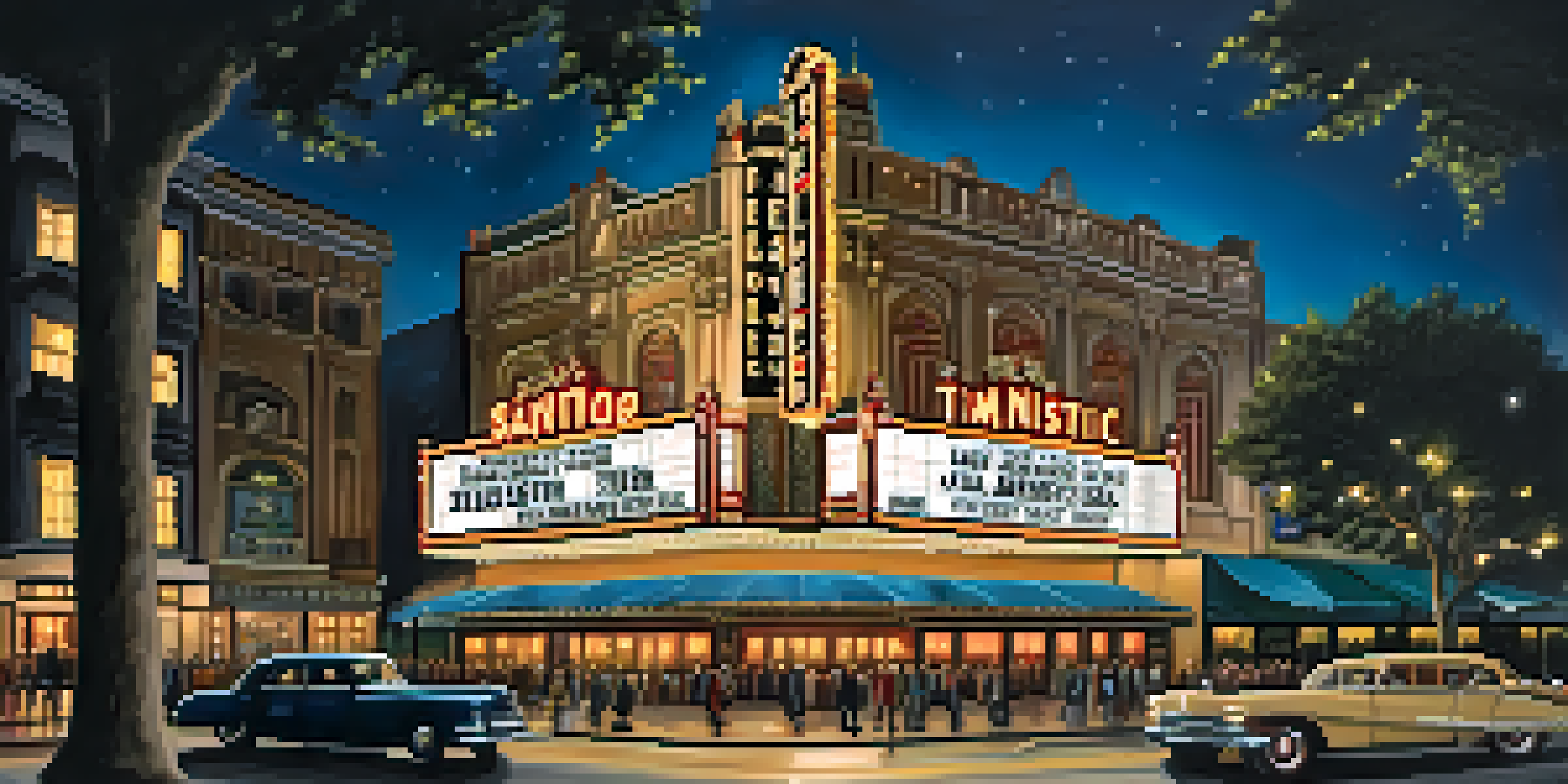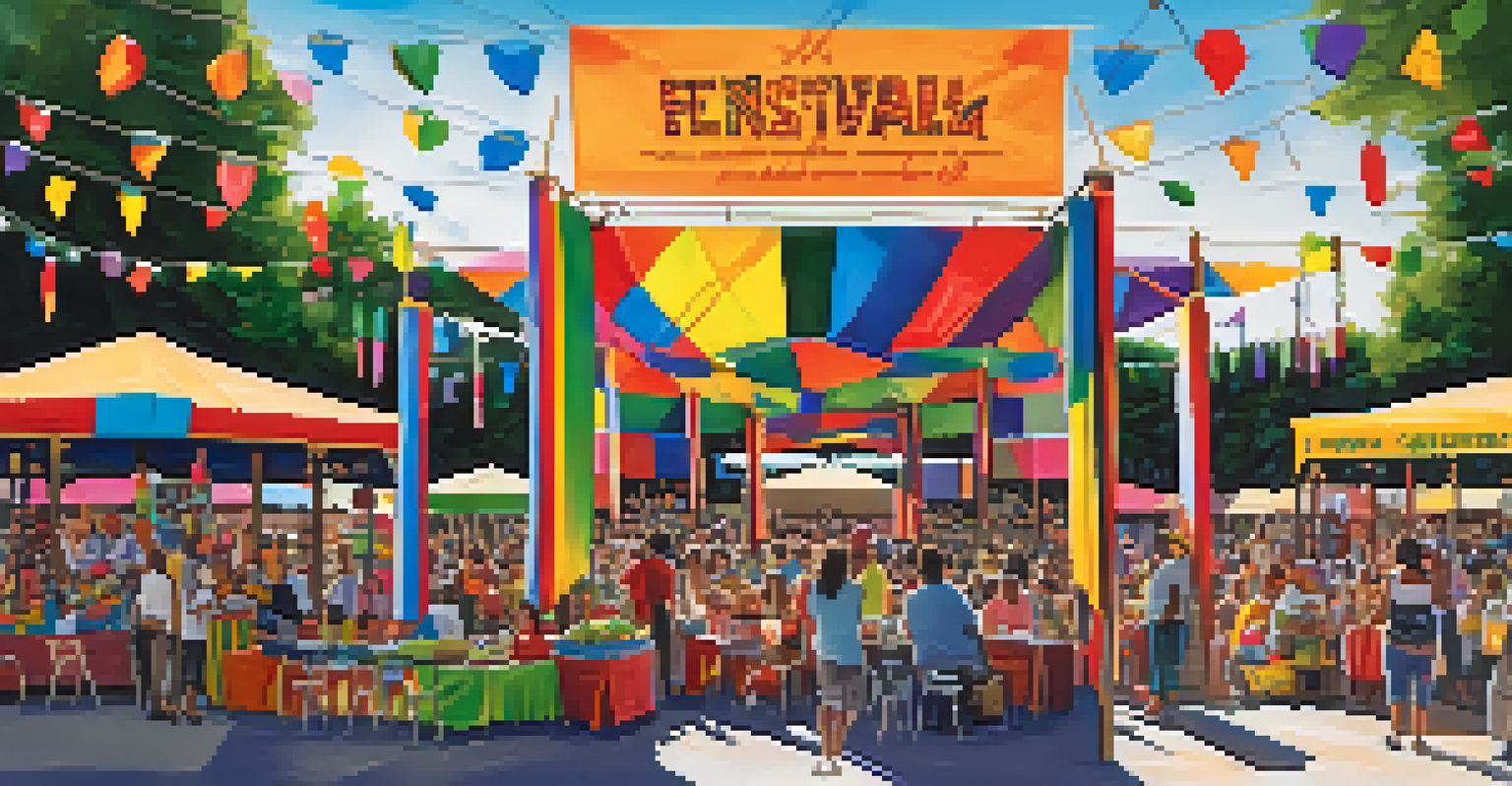Theater Scene in San Antonio: A Hub for Creative Performances

The Rich History of Theater in San Antonio
San Antonio boasts a vibrant theater history that dates back to the early 19th century. The city has been home to various performing arts venues, each contributing to its unique artistic landscape. From the historic Majestic Theatre to the more modern Tobin Center for the Performing Arts, these spaces have hosted countless productions that reflect the community's evolving tastes.
Theater is a mirror to the world, reflecting our joys, our sorrows, and the complexities of our shared human experience.
A pivotal moment for the city's theater scene occurred in the 1920s when the Majestic Theatre opened its doors. This stunning venue not only showcased films but also live performances, setting the stage for future artistic endeavors. As the city grew, so did its passion for the performing arts, leading to the establishment of numerous local companies and festivals.
Today, San Antonio's theater history is celebrated through events like the annual San Antonio Theatre Festival, which highlights both local talent and national productions. This deep-rooted appreciation for theater continues to inspire new generations of artists and audiences alike.
Diverse Performance Styles and Genres
One of the most exciting aspects of the San Antonio theater scene is its diversity in performance styles and genres. From traditional plays and musicals to innovative experimental works, there’s something for everyone. Local theater companies often tackle a mix of classic and contemporary pieces, ensuring that all tastes are catered to.

For instance, the Classic Theatre of San Antonio frequently produces timeless works by playwrights like Shakespeare, while the Overtime Theater is known for its original, avant-garde productions. This blend of genres not only enriches the local culture but also fosters a sense of community among theater-goers.
Rich Theater History in San Antonio
San Antonio's theater scene has a vibrant history marked by iconic venues and a passion for the performing arts.
Additionally, various festivals, such as the Alamo City Black Historical Festival, showcase works from underrepresented voices, making the theater scene even more inclusive. This commitment to diversity ensures that audiences can experience a wide array of narratives and perspectives, enhancing the city’s cultural tapestry.
The Role of Community Theaters
Community theaters play a crucial role in San Antonio's vibrant arts scene, offering a platform for local talent to shine. These grassroots organizations foster creativity and collaboration while engaging residents in the performing arts. Often run by passionate volunteers, community theaters bring together actors, directors, and playwrights from various backgrounds.
Theater is the most immediate way in which a human being can share with another the sense of what it is to be a human being.
Organizations like the San Antonio Community Theatre and the Woodlawn Theatre provide opportunities for aspiring artists to hone their craft and gain valuable experience on stage. These venues often present affordable tickets, making theater accessible to everyone in the community. Such inclusiveness encourages a love for the arts among all ages.
Moreover, community theaters frequently collaborate with local schools and organizations to host workshops and educational programs, inspiring the next generation of performers. By nurturing local talent and encouraging audience participation, these theaters contribute significantly to the overall growth of the San Antonio performing arts landscape.
An Array of Theatrical Venues
San Antonio is home to a variety of theatrical venues, each offering a unique experience. From intimate black box theaters to grandiose auditoriums, the city caters to every type of performance and audience. This diversity not only enhances the viewing experience but also attracts a wide range of productions.
The historic Aztec Theatre, known for its stunning architecture, hosts concerts and theatrical performances, providing a spectacular backdrop for any show. In contrast, smaller venues like the Cellar Theatre offer an intimate setting that allows for close interaction between performers and audiences. Such variety keeps the theater scene dynamic and engaging.
Diverse Genres and Community Focus
The city's theater offers a wide range of performance styles, fostering inclusivity and showcasing underrepresented voices.
Additionally, the Tobin Center for the Performing Arts serves as a modern hub for both local and touring productions, drawing in nationally recognized artists. This blend of old and new venues reflects San Antonio’s rich cultural heritage while paving the way for future artistic endeavors.
Impact of Festivals on Local Theater
Festivals play a pivotal role in elevating San Antonio's theater scene, bringing together artists and audiences for a celebration of creativity. Events like the San Antonio Theatre Festival and the CineFestival showcase a wide range of performances, from theatrical productions to film screenings. These gatherings create an exciting atmosphere that encourages community engagement and support for the arts.
Moreover, festivals often provide emerging artists with the chance to present their work to larger audiences. For instance, the Teatro Salón Festival highlights Latino theater, allowing for cultural exchange and representation within the performing arts. This exposure can lead to new opportunities and collaborations that benefit local artists.
The impact of these festivals extends beyond just entertainment; they foster a sense of pride and unity within the community. As residents come together to celebrate the arts, they bolster San Antonio’s reputation as a vibrant cultural hub, attracting visitors and artists alike.
Educational Opportunities in Theater
San Antonio's theater scene is not just about performances; it also emphasizes education and skill development. Several institutions offer programs and workshops aimed at nurturing aspiring performers, directors, and writers. These educational opportunities help cultivate the next generation of talent in the local theater community.
Organizations like the Magik Theatre focus on youth education, providing classes and summer camps that introduce children to the world of theater. Such programs instill confidence and creativity in young minds, encouraging them to explore their artistic potential. Additionally, local colleges and universities often host theater programs that offer hands-on experience and training.
Educational Programs for Future Talent
Local organizations prioritize educational opportunities, nurturing the next generation of artists through workshops and classes.
Furthermore, partnerships between schools and local theaters enhance access to arts education. By providing students with opportunities to attend live performances and participate in workshops, the community fosters a lifelong appreciation for the arts. This commitment to education ultimately strengthens San Antonio's theater scene and supports its ongoing growth.
The Future of Theater in San Antonio
As the theater scene in San Antonio continues to evolve, its future looks promising. With a growing interest in the arts and a supportive community, local theater companies are finding innovative ways to engage audiences. The rise of digital performances and hybrid models has opened new doors for artists to showcase their work, adapting to changing audience preferences.
Moreover, increased collaboration among local theaters and organizations fosters a spirit of unity and creativity. By sharing resources and knowledge, these entities can produce more ambitious projects and reach wider audiences. This collaborative approach not only enhances the quality of productions but also strengthens the overall theater community.

Ultimately, the future of San Antonio's theater scene hinges on its adaptability and commitment to diversity. By continuing to embrace new ideas and voices, the city can ensure that its rich artistic heritage thrives for generations to come.